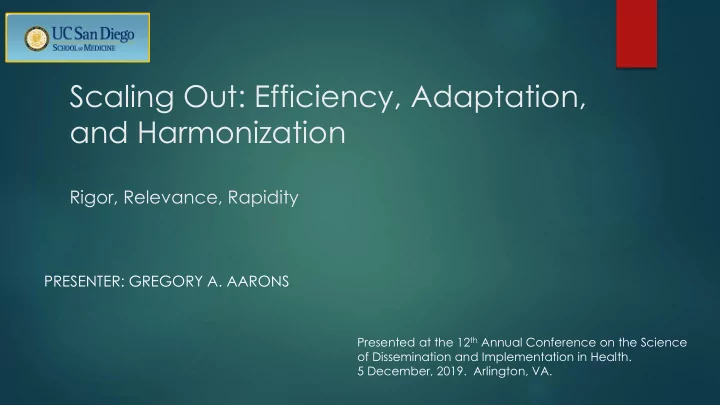

Scaling Out: Efficiency, Adaptation, and Harmonization Rigor, Relevance, Rapidity PRESENTER: GREGORY A. AARONS Presented at the 12 th Annual Conference on the Science of Dissemination and Implementation in Health. 5 December, 2019. Arlington, VA.
Acknowledgements Funding National Institute on Drug Abuse Swedish Research Council FORTE Sweden National Institute on Drug Abuse National Institute of Mental Health Norwegian Ministry of Health and Care Services Contributors C. Hendricks Brown, Nanette Benbow, Brian Mustanski (Northwestern University). Ulrica von Thiele Schwarz (Mälardalen University and Karolinska Institutet) Henna Hasson (Karolinska Institutet) Karina Egeland, Ane-Marthe Solheim Skar, Erlend Laukvik (Norwegian Center for Violence and Traumatic Stress Studies – NKVTS) Marisa Sklar, Lauren Brookman-Frazee (UC San Diego) Aubyn Stahmer (UC Davis)
Outline Challenges: efficiency, dealing with adaptation, and comparison across studies Scaling out: Advancing Efficiency in Implementation Science The Value Equation: Reconciling fidelity and adaptation for stakeholders involved in implementation? Planning for assessment of common mechanisms
Can interventions be expected to produce effects similar to those found in previous studies? Scaling-out is an approach to adapting and delivering EBIs across health and allied health service systems and organizations and/or across different target populations. Scaling-out is the deliberate use of strategies to implement, test, improve, and sustain EBIs as they are delivered in novel circumstances distinct from previous implementations. EBI implementation in a moderately different setting, or with a different population, can “borrow strength” from evidence of impact from prior trials. Aarons, G. A., Sklar, M., Mustanski, B., & Benbow, N., & Brown, C. H., ( 2017). “Scaling - out” evidence -based interventions to new populations or new health care delivery systems. Implementation Science , 12 (1), 111.
Questions for - scaling-out Every EBI implementation raises (at least) three questions: Is there sufficient evidence that this EBI would impact health as expected with a 1. different population or in a new setting? Are system, organization, and/or EBI adaptations necessary, sufficient, and 2. culturally appropriate to make the EBI feasible, practical, acceptable, and effective in the new context? Will proposed mechanisms (e.g., mediational pathways) hold as in prior trials? 3.
Two main types of scaling-out Type I: Population fixed, Type II: Delivery system fixed, different delivery system different population EBI is delivered through different EBI delivered to a different delivery system to same population within a similar population where it has service system where it has previously been tested previously been tested
1) The end product of implementation efforts should emphasize overall value rather than only the intervention effects 2) Implementation strategies can be construed as a method to create fit between EBIs and context, and 3) Transparency is vital; not only for the intervention but for all of the four terms of the equation.
Fidelity-Adaptation: The Value Equation von Thiele Schwarz, U., Aarons, G. A., & Hasson, H. (2019). The Value Equation: Three complementary propositions for reconciling fidelity and adaptation in evidence-based practice implementation. BMC health services research , 19 (1), 868.
Example: Leadership and Organizational Change for Implementation (LOCI): Documenting Adaptations for Comparative Analysis What is ADAPTATION Level REASON Modified Content Context Process System Agency Clinic Provider Switch from mental health to substance abuse X X X X Funding source X Extension of timeline and added booster session X X X Results of pilot study showing increased X effects starting at six months Switch from general EBP to MI focus (content of X X X Goal of linking LOCI to specific X X training, measures) implementation outcomes Integration of fidelity monitoring and feedback X X X Alignment of LOCI with the implementation X into LOCI components Expansion of organizational strategy meetings Results of pilot study and recognition of (more regular meetings, climate development X X importance of alignment of leadership plan, etc.) across levels Updated content around findings of dimensions Alignment of LOCI with updated measure X X X X of ILS and ICS scales development Adapted and overly simplified from : Stirman, S. W., Baumann, A. A., & Miller, C. J. (2019). The FRAME: an expanded framework for reporting adaptations and modifications to evidence-based interventions. Implementation Science , 14 (1), 58.
Be explicit about mechanisms Mechanisms LOCI Norway to Implement PTSD treatment - NIMH
Summary of Considerations for scaling-out Scaling-out can improve efficiency and examine generalizability in implementation studies Clearly identify core elements of the EBI and what can be adapted Also applies to implementation strategies Reconciling fidelity and adaptation should consider perspectives and needs of multiple stakeholders Documenting mechanisms and harmonization of measures are needed to accelerate knowledge of effective implementation strategies
Contact Gregory Aarons, Ph.D. UC San Diego, Department of Psychiatry UCSD Dissemination and Implementation Science Center (UCSD-DISC) Child and Adolescent Services Research Center (CASRC) Web: https:episframework.com http://profiles.ucsd.edu/gregory.aarons http://implementationleadership.com/ e-mail: gaarons@health.ucsd.edu
Recommend
More recommend